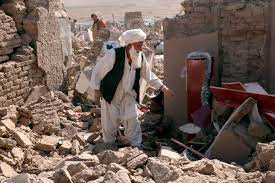
Afghanistan is reeling from the aftermath of a series of devastating earthquakes that have claimed the lives of over 2,400 people, marking one of the deadliest seismic events the nation has experienced in years. The Taliban administration confirmed the grim toll as the country faces an urgent humanitarian crisis.
The powerful earthquakes, which struck on Saturday in the western region of the country, were centered approximately 35 km (20 miles) northwest of Herat, with one registering at a magnitude of 6.3, according to the US Geological Survey (USGS). These tremors rank among the deadliest earthquakes witnessed globally this year, following the tragic events in Turkey and Syria in February, which claimed an estimated 50,000 lives.
Janan Sayeeq, spokesperson for the Ministry of Disasters, reported that the death toll has climbed to 2,445, while revising the number of injured to “more than 2,000.” Earlier reports had suggested that 9,240 individuals had been injured, emphasizing the scale of the catastrophe.
The earthquakes also caused extensive damage to homes, with 1,320 houses reported as damaged or destroyed. The initial death count had been lower, with the Red Crescent initially reporting around 500 casualties.
Rescue efforts are in full swing, with ten teams dispatched to the affected area, which shares a border with Iran. Hospitals in Herat have been inundated with more than 200 deceased individuals, many of whom are women and children.
The dire situation prompted the establishment of makeshift beds outside the primary hospital in Herat to accommodate the influx of victims, as seen in images circulated on social media.
Suhail Shaheen, the head of the Taliban political office in Qatar, issued a plea for urgent assistance, stating that the affected region requires immediate supplies of food, drinking water, medicine, clothing, and tents to support the ongoing rescue and relief operations.
The historic minarets of Herat, known for their architectural significance, have also sustained damage, with photographs on social media displaying visible cracks and fallen tiles.
Afghanistan, nestled amidst mountainous terrain, has a history of powerful earthquakes, many of which originate in the rugged Hindu Kush region along the Pakistan border. Casualty figures often surge as information trickles in from remote areas, where war-torn infrastructure and logistical challenges complicate relief and rescue efforts.
The healthcare system in Afghanistan, heavily reliant on foreign aid, has faced severe funding cuts in the two years since the Taliban assumed power. These cuts, coupled with concerns over the Taliban’s restrictions on women and competing global humanitarian crises, have led to a reduction in financial support from international donors.
The situation remains critical, with an uncertain road ahead for Afghanistan as it confronts the tragic aftermath of these deadly earthquakes and grapples with the challenges of rebuilding and recovery.
Sources By Agencies


